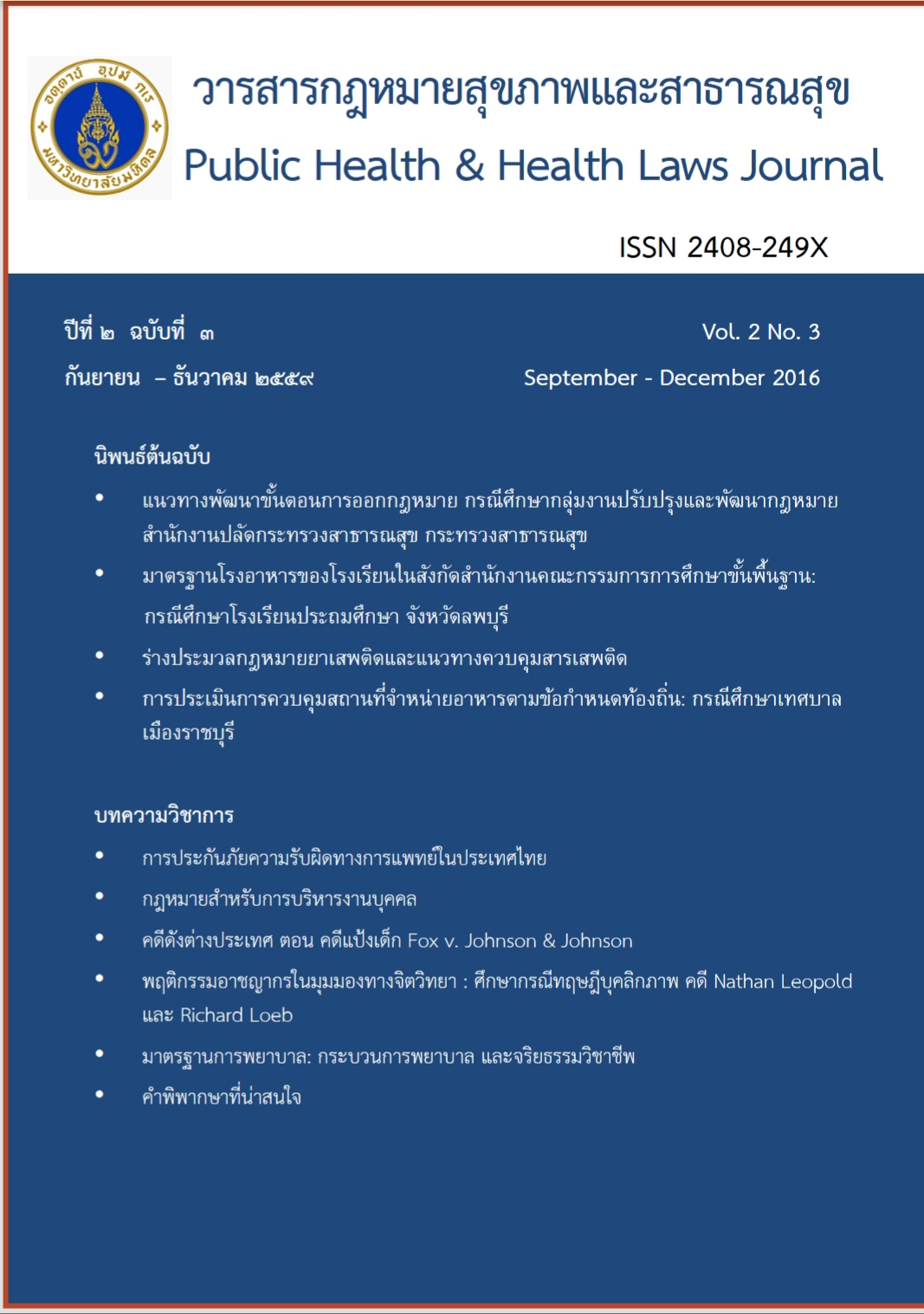School Cafeteria Standard under the Administration of Basic Education Office : A case study of primary school in Lopburi Province
Keywords:
cafeteria standard / food sanitation / coliform bacteria inspection / primary schoolAbstract
This study was a survey research. The objective of this study was to investigate the cafeteria standard of schools under the Office of the Basic Education Commission. The population was 10 elementary school cafeterias in Lopburi province. The tool used was surveys on the cafeteria sanitation standard of the Department of Health and SI-2. Data were analyzed through descriptive statistics including mean.
The results of this study found that cafeterias that did not meet at the sanitary standards of which a very good level was set at 70.00 percent. No school cafeteria passed this very good level of standard. The aspects that failed the most were the food, water, ice, and beverage, followed by food containers. For schools which did not meet any of the standards, it was due to the sinks not having drains, not having grease traps, and not having an annual medical examination of food handlers. According to food testing detection of bacteria in food it was found that main course over rice was the most contaminated, particularly foods that contain coconut milk which was contaminated with bacteria at 57.14 %, followed by noodle shop venders, with the most contamination found in meat balls with contamination at 50 %. As for the containers, chopsticks were found to be contaminated the most at 50.00 %, plates and bowls at 41.91 %, and forks and spoons at 33.33 % respectively. As for food handlers, it was found that a la carte vendors were contaminated at 50.00 %, noodle venders were found to be contaminated at 25.00 %, and the main course over rice venders was at 23.01 %. There was no difference in the aspect of cook and servers. The results of the study found that there were 2 aspects that caused the cafeteria to not meet the sanitary standards; the cafeteria structure and food handlers.
The suggestion from the study is to form a clear assessment of the cafeteria. This is because the first part of the standard is to assess the structure of the school. The school administrators are the only ones that can make the schools pass the standards. The second part is an assessment of food handlers. The conclusion of the cafeteria assessment is based on the assessment on 2 aspects. The school administrators have policies on food sanitation system management such as sewers, wash basin, and grease traps. The school has a duty to set a standard that all vendors must meet regard less of the food vendors changes over many years.
References
กองสุขาภิบาลอาหารและน้ำ. (2547). แบบสำรวจโรงอาหาร ตามมาตรฐานการสุขาภิบาลอาหารกรมอนามัย กระทรวงสาธารณสุข. พิมพ์ครั้งที่ 2. โรงพิมพ์องค์การสงเคราะห์ทหารผ่านศึก, กรุงเทพฯ.
กรมอนามัยสำนักสุขาภิบาลอาหารและน้ำ. (2553). ข้อกำหนดด้านสุขาภิบาลอาหารสำหรับร้านอาหาร. จังหวัดนนทบุรี: บจก. โรงพิมพ์สำนักงานพระพุทธศาสนาแห่งชาติ.
งานระบาดวิทยาและข่าวกรอง กลุ่มงานโรคติดต่อ สำนักงานสาธารณสุขจังหวัด ลพบุรี. (2558).
จิรพรรณ พรหมลิขิตชัย. (2556). สถานการณ์การเฝ้าระวังสุขาภิบาลอาหารในสถานประกอบการ ปี 2554- 2555. วารสารสุขาภิบาลอาหารและน้ำ; 6-12.
ณัฐนันท์ จิวเจริญสกุล. (2551). การสุขาภิบาลอาหารของโรงอาหารในโรงเรียนมัธยมศึกษาของรัฐบาล ในจังหวัดปราจีนบุรี ตามความคิดเห็นของผู้เกี่ยวข้อง. มหาวิทยาลัยเกษตรศาสตร์.
ดารณี แก้วจุมพล. (2550). สถานการณ์การปนเปื้อนเชื้อโคลิฟอร์มแบคทีเรียในอาหารถุงที่วางจำหน่าย ในตลาดสดประเภทที่ 1 พื้นที่รับผิดชอบศูนย์อนามัยที่ 6 ขอนแก่น. ขอนแก่น: ศูนย์อนามัยที่ 6.
ธีรภัทร์ ฉ่ำแสง. (2556). การเฝ้าระวังด้านสุขาภิบาลอาหารและน้ำในโรงเรียนในเขตพื้นที่ศูนย์อนามัย ที่ 2 สระบุรี. วารสารสุขาภิบาลอาหารและน้ำ; 14-18.
นฤมล วีระพันธ์, ปราณี ทองคำ. (2550). ปัจจัยที่มีผลต่อสภาวะการสุขาภิบาลอาหารตามหลักเกณฑ์ข้อ กำหนดมาตรฐานของร้านอาหารในเขตอำเภอเมือง จังหวัดปัตตานี. วารสารสงขลานครินทร์; 13(2): 187-200.
ไพจิตร วรรณจักร์. (2549). การศึกษาลักษณะทางกายภาพและชีวภาพของสถานที่จำหน่ายอาหารที่ ได้รับป้ายอาหารสะอาด รสชาติอร่อย ในพื้นที่รับผิดชอบศูนย์อนามัยที่ 6 ปีงบประมาณ 2548. ขอนแก่น: กลุ่มพัฒนาการส่งเสริมสุขภาพและพัฒนาอนามัยสิ่งแวดล้อม ศูนย์อนามัยที่ 6.
พรสุดา ผานุการณ์. (2549). การศึกษาสภาพการสุขาภิบาลอาหารของโรงอาหารในโรงเรียนเขตกรุงเทพมหานคร.
ภัทราพร จุลราช, มาริษา ภูภิญโญกุล, อบเชย วงศ์ทอง. (2550). การสุขาภิบาลร้านอาหารหวานและเครื่องดื่มและสิ่งแวดล้อมของโรงอาหารโรงเรียมัธยมศึกษาตอนปลายในจังหวัดสกลนคร. วารสารวิจัยมหาวิทยาลัยขอนแก่นฉบับบัณฑิตศึกษา; (7).
ศากุน เอี่ยมศิลา, โสภณ หมวดทอง, วิไลวรรณ โกยทอง และสิงค์คร พรมขาว. (2547). การจัดการสุขาภิบาล อาหารและน้ำบริโภคในโรงเรียน. กองสุขาภิบาลอาหารและน้ำ กรมอนามัย.
สำนักระบาดวิทยา กรมควบคุมโรค. (2557). รายงานสถานการณ์การระบาดของโรคอุจจาระร่วง.
สุชาติ สุขเจริญ. (2555). การศึกษาปัจจัยที่เกี่ยวข้องกับสุขลักษณะของอาหารและน้ำในศูนย์เด็กเล็ก. กลุ่มวิจัยและพัฒนาระบบสุขาภิบาลอาหารสำนักสุขาภิบาลอาหารและน้ำกรมอนามัย.
สุวรรณ แช่มชูกลิ่น. (2548). ความแตกต่างของสภาวะการสุขาภิบาลอาหารและน้ำบริโภคในโรงเรียน เขต 13. ศูนย์อนามัยที่ 5 นครราชสีมา.
Downloads
Published
How to Cite
Issue
Section
License
Disclaimer and Copyright Notice
The content and information presented in articles published in the Journal of Law and Public Health Policy represent the opinions and sole responsibility of the respective authors. The editorial board does not necessarily agree with or assume any responsibility for the views expressed.
All articles, data, content, images, and other materials published in the Journal of Law and Public Health Policy are the intellectual property of the journal. Any individual or organization wishing to reproduce, distribute, or otherwise use the entirety or any part of such materials must provide proper citation.





